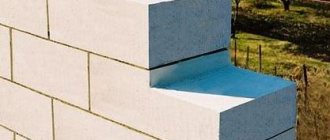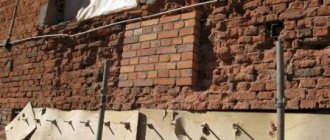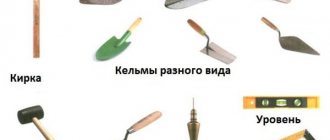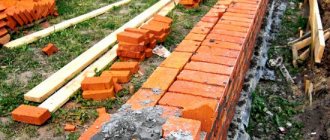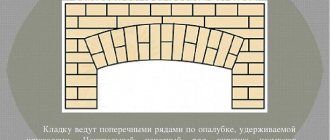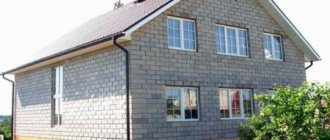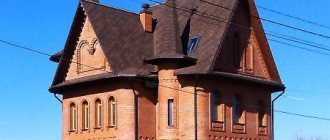The masonry injection method has been known for quite some time, and it is used to correct problems with masonry. This helps strengthen the masonry and avoid further destruction. Firststroy portal . ru
will tell you in detail about the technology of strengthening brick walls using injection. We talked about the method of injecting reinforced concrete walls and structures earlier.
Application
- Restoring the integrity of buildings Protecting reinforcement and porous materials from penetration of air and moisture into structures To prevent water from entering the building
The use of technology is effective in restoring brick structures in the following cases:
- Formation of cracks under increased loads When exposed to external factors, walls are partially or completely destroyed Masonry cracks due to uneven settlement of the structure
More interesting materials:
How to cut brick
Brick. The most popular and simple
Decorative brick
Advantages of expanded clay concrete blocks
Cementing materials, their functions and properties
Injection is included in major renovation works of buildings.
Sometimes the only possible action that can save a building from destruction is injecting cracks with a special solution. The walls of brick masonry structures, strengthened by the creation of reinforcing internal ties, are considered one of the universal methods for restoring load-bearing structures. This suggests that walls can be strengthened by injection for any type of deformation.
The essence of this method is that the cracks that appeared inside the brickwork are filled with special compounds. To carry out this work, holes are drilled that cross the detected cracks in the masonry and injection compounds are injected into them under high pressure. The difficulty is that the work is done blindly and therefore requires experience.
3.4. Compositions used for injection insulation (polymer cement).
3.4.1. Quick-setting compacting mixture (BUS):
— aluminate-silicate non-toxic binder;
- properties:
self-sealing;
intensive expansion;
waterproof when caulked;
ease of clumping and good caulking.
— technical data: base — aluminous expanding cement, Portland cement, aluminous cement, chrysotile asbestos; color - gray;
- water-cement ratio of cement paste 0.28 - 0.32;
- waterproof - should be waterproof after 24 hours;
— consumption: 2 kg/l voids.
3.4.2. Composition of Asocret-BM:
- consists of cement and lime;
— designed for filling cavities in stone walls, especially when creating a horizontal barrier.
- technical data:
base - a solution containing cement; color - gray; dry density - 0.9 kg/dm3; wet density - 2 kg/dm3;
— time of working with the material — 1 hour;
— consumption: 2 kg/l voids.
Materials used
They are divided into three types:
Liquids are defined as solutions that are free of particles and have a viscosity comparable to that of water. These include a solution of chemicals, synthetic resins and organic binders.
Unstable suspensions are an aqueous solution of cement and stone flour. Homogeneity is maintained during the mixing process. When mixing stops, they separate.
Stable suspensions - their sedimentation process is slower, this makes it possible to perform an injection before the filler begins to settle. The introduction of plasticizing additives makes it possible to achieve stability of the solution.
Before starting the repair of a brick wall, the crack is opened with the help of a scarpel, the crumbs of stones are cleaned, and washed with water. Then it is filled with solution.
Crack injection is performed in three stages:
- Preparation of wellsInstallation and casting of injection tubesInjection of mixture
The number of wells is set on the basis of at least two pipes per crack.
Embedment depth -5-7cm, diameter -1.8-2.5cm. Wells are made at an angle of 60 degrees to the vertical surface to ensure good flow of the mixture into the masonry crack. The tubes are sealed with a 1:3 solution.
If the size of the cracks is large, then tow impregnated with resin or liquid glass is placed around the tube. Then it is minted. To attach the hose to the tube, its end is made to protrude 5-8 cm above the surface.
Two tubes are installed in the area to be treated; the mixture is injected into one, and the other for control. The mixture is pumped using a hand pump. For small volumes, a syringe is used.
The pressure when injecting the solution is up to 4 atm, and there are cases when the pressure rises to 12 atm. The duration of the procedures is no more than 10 minutes. The tubes are then removed 6 hours after the end of the injection.
Healing cracks in brickwork
Injection is performed by different types of solutions, and definitions are given by their names:
- Silication Bituminization Smolization Cementation
Silication is carried out in two stages. The first is that liquid glass is injected through drilled wells, it penetrates through cracks into the structure and fills them. The second is to inject a solution of calcium chloride.
It reacts with liquid glass to form sparingly soluble calcium hydrosilicate and insoluble silica gel. Silication is used to heal cracks in structures that operate in aggressive environments. Bituminization - injection of grade 111 bitumen heated to 200-300 degrees, the humidity of the structure should be low to prevent vaporization.
Increases water resistance and corrosion resistance. Resmolization – injection of epoxy resin compounds. Increases structural strength and corrosion resistance.
Cementation of cracks is the most common method of healing cracks. A cement mixture of different compositions is used. This depends on the width of the cracks.
The cement mixture is prepared on the basis of Portland cement or well cement. Brands 400 and 500 are used. Pour cement into water and mix vigorously for 3 minutes.
The finished mixture is filtered through a sieve. The sieve is taken with holes 0.5-1mm. The mixture must be used no later than 30 minutes from the moment of production.
The condition of the brickwork during the operation of the building depends on many factors.
But the greatest influence on the masonry is, of course, atmospheric phenomena. Temperature changes that occur in autumn and spring, when the air temperature jumps from negative to positive during the day, have a particularly detrimental effect. But the cause of cracks and other defects may not necessarily be meteorological phenomena; it is likely that the building is subject to shrinkage and deformation of the soil foundation.
Moreover, if the brickwork was not laid according to the rules, the composition of the mortar was not followed, then microcracks appear in the masonry, which over time become larger and larger under the influence of water, which freezes in the cracks and causes internal stresses in the masonry.
There are different cracks depending on the degree of danger. The most dangerous for the load-bearing structure of a building are cracks with an opening greater than 0.2 mm, water-saturated cracks and cracks with leaks. Such defects must be eliminated first. It is very effective to eliminate such defects by injecting brickwork.
Injection of brickwork is a method of eliminating defects by pumping various binders into the damaged area. For example, acrylate gels or epoxy resins. You can also pump in special cement—microcement. This technology is also used to repair waterproofing of foundations and various underground structures.
Waterproofing for penetrating brickwork is made from high-grade cements with the addition of certain additives and quartz sand. Once in a crack, such concrete forms insoluble crystals that protect the cracks from water ingress, but at the same time are capable of allowing individual molecules to pass through in the form of steam, thereby allowing concrete to breathe. Typically, injection of brickwork is carried out during the restoration and repair of old buildings. If water enters through a crack, then the crack is injected with special polymer resins, which set very quickly and prolong the life of the masonry.
3.3.3. Injection composition "Akvafin-SMK":
— silicone microemulsion concentrate prepared on the basis of silanes and oligomeric siloxanes;
- used for horizontal waterproofing - barrier to rising capillary moisture;
— technical data: base — silane/siloxane; color - transparent; specific gravity - 0.95 g/cm3. Shelf life: 9 months, store in a warm place;
- consumption: 1.5 - 2 kg of concentrate per 1 m2 of cross-sectional area of the wall;
— does not contain solvents, odorless, non-flammable, harmless to health.
Brick masonry injection technology
First you need to prepare the wall for injection. To do this, holes are drilled in the wall at a distance of about 25 cm from each other.
Moreover, the depth of these holes is about 90% of the wall thickness, i.e. the wall is drilled almost right through.
Then comes the preparation of solutions, these can be polyurethanes or polymer solutions based on epoxy resin. After the preparatory steps, the fastening solution is directly injected into the brickwork through special pipes using a pump. Reinforcement is provided if necessary.
Thanks to the use of this technology, the brick wall is sealed, damaged areas are restored, and the strength of the walls increases up to 2 times.
Injection of brickwork allows you to quickly and efficiently carry out repairs and waterproofing, without removing damaged areas of the masonry.
Injection is the process of filling voids, cracks and various cavities with a special compound in brickwork.
The purpose of this technology is the ability to strengthen or glue the structure or prevent the penetration of moisture and harmful products that increase corrosion and violate the integrity of the object.
Cracks in brickwork can appear absolutely anywhere, and in some cases the integrity of the masonry can only be restored by injection.
The injection procedure is carried out by injection under pressure of a semi-liquid or liquid solution, which includes both cement and complex polymer components. Its content will depend on the specifics of the work and the task at hand, as well as the condition of the structure.
Especially often, such a need arises when reconstructing an existing building due to its physical wear and tear. During the work, it is necessary to change the level of loaded brickwork or repair damage to the wall. It is worth noting that traditional methods of one-sided building and strengthening of brickwork using clips or reinforced concrete jackets are effective and reliable, but require stopping the operation of the building while the work is being carried out.
In addition, the above-mentioned technologies cannot be used on sites of historical value, since the unique decorative finish makes it difficult to access damaged areas. And the only possible way to restore integrity in such situations is injection technology.
The most effective and popular solutions for injecting cracks are solutions based on polymeric materials and epoxy resins.
Injection of masonry in order to strengthen and restore it is carried out with cement, polymer or polymer-cement mortars.
But at the moment, the possibilities for improving the cement composition are almost exhausted. Solutions based on polymeric materials, especially epoxy resins, are considered the most effective. However, their high cost, the need for maximum liquefaction and slow curing of the material in high humidity conditions somewhat limit their use.
Therefore, the optimal composition for injection will be a cement-polymer solution containing the addition of polymers. Practice shows that removing cracks in brickwork not only completely restores the integrity of the structure, but also increases the strength effect by 15...20%.
To inject cracks in brickwork, a suspension of three main types is used:
Brick wall injection scheme
- Liquid.Stable.Unstable.
A liquid suspension is a solution whose viscosity matches that of water. This type includes solutions of synthetic resins, chemicals, and organic binders. A characteristic feature of the second type of solution is the slow process of sedimentation, which allows injection to be performed before the filler begins to settle.
To achieve stability of the solution, plasticizing additives are introduced into its composition or treated with unstable suspensions in special mixers. Unstable suspensions include aqueous solutions of cement, stone flour or bentonite clay. Uniformity of the composition is achieved by kneading, but after the process is stopped, it begins to separate again.
Bonding cracks on a brick wall is done with pumps of various types and volumes, which are selected depending on the type of mortar and the specifics of the work.
Parkers are used to inject the repair mixture into the crack. The functional purpose of this element is to prevent leakage of the injection composition. The selection of parkers depends on the solution used, working conditions and ease of use.
Advantages and disadvantages
The presented technique has its advantages and disadvantages.
Before starting work and restoration, it is important to familiarize yourself with the following advantages :
- performing work in different weather conditions;
- minimal time and labor costs;
- in the process of restoration work, a monolithic waterproofing layer is created, on which there are no seams or joints;
- emergency leaks can be eliminated quickly and easily;
- possibility of using water under high pressure;
- as a result of restoration, the load-bearing strength of the walls and foundation increases;
- the material may come into contact with drinking water.
But there are also disadvantages that may affect the final decision when choosing. Materials and equipment are expensive, so not every person will be able to afford restoration work. In order for the concrete base to be strong, it is necessary to follow the sequence of technology.
If you do not contact specialists and do the restoration yourself, you can damage the integrity of the structure. Cracks and hollow structures can collapse under extreme pressure. The consequences in this case will be irreparable. Before starting work, it is important to remember the financial costs. Restoration and restoration work of a concrete monolith should be entrusted to qualified craftsmen.
Technological sequence of work
Injection work is best done in the morning. At this time, the temperature of the structure does not exceed +5ºС, which allows for maximum crack opening. At the same time, you should not reduce the load on the brick wall during sealing, as this may partially close the crack, thereby reducing the quality of the injection.
The work is performed in the following sequence:
Surface preparation. At this stage, the brickwork is cleaned of bitumen, gypsum, oils, lubricants, paint, dust and other separating layers. Cement or lime mortar present on the surface must be removed with a grinding or sandblasting tool. Create rectangular 2x3 cm fines on the working surface along the entire length of the crack.
It is desirable that the jointing be dovetailed. On the wall on both sides, in a checkerboard pattern, drill channels along the treated surface in increments of 15...40 cm. In this case, the channel should cross the crack and be drilled at an angle from top to bottom. Its angle of inclination should be at least 10º relative to the horizon. Blow channels and cracks with compressed air. Install parkers. Moisten channels and cracks evenly with water.
This process must be carried out in advance so that the surface is evenly moistened at the time of injection. Prepare the repair mixture according to the instructions. Apply the repair mixture to the fines. In this case, they are used as permanent formwork and thereby prevent the mortar from leaking out of the cracks. Also seal the place where the parkers are installed. Introduce the mixture through the parkers, starting from the bottom up and maintaining a pressure of 1...2 atm. Dismantle the parkers. After the solution has hardened, clean the treated surface, and caulk the places where the parkers are installed with a repair compound.
Restoring a brick wall using this method can significantly reduce the consumption of metal, finances and, in comparison with traditional methods, reduce the time required for repair work. In addition, injection increases the strength of stone structures several times.
- Date: 03/15/2015 Comments: Rating: 40
When examining brick structures, many are faced with damage to load-bearing structures, among which the most popular defects are cracks. If such damage is detected, it is recommended to repair it as soon as possible. This is due to the fact that cracks in the brickwork are conductors of cold, which can lead to freezing of the walls during the cold season.
The causes of cracks in brickwork can be: shrinkage of the house, lack of rain drainage on the roof, errors in the design of the building itself, and others.
Since the bulk of all defects are cracks no more than 6-8 mm wide, an injection procedure is used to seal them.
Factors that influence wall failure
Gradual deterioration of the internal and external integrity of the completed masonry can occur for many reasons. Most often, this situation is associated with incorrect calculation of the maximum level of load on the laid foundation and violation of construction technology. Soil heterogeneity negatively affects the stability of the structure.
Novice craftsmen often forget about expansion joints, and also do not check the level of the upper aquifers. Common negative factors include shrinkage of the foundation, as well as the standard depth of its foundation and deformation processes in beams that arise due to constant exposure to high humidity.
Destruction of the masonry may occur due to the increased weight load of the snow cover. A large accumulation of atmospheric precipitation puts increased pressure on supporting structures, which causes not only weakening of the structure, but also its gradual destruction. Quite often the main reason lies in a leaking roof. A huge amount of water accumulates in the internal compartments of brick walls, destroying the material.
The masonry loses its functions gradually, and the tension that forms at the first stage is absolutely invisible to others. Only professionals can notice changes, who are able to determine the presence of destructive processes even by the smallest cracks. Gradually, the cracks in the walls become larger and grow together, which can significantly damage the integrity of the entire structure. In advanced cases, cold air penetrates into the house through cracks, which can lead to freezing.
Through cracks
In sunny weather, the brick begins to gradually thaw, and the wall itself becomes damp and becomes a favorable environment for the appearance of fungi and mold. The decorative coating is also subject to destruction, becoming cracked and peeling off. Ceramic tiles and plaster may fall off the surface.
At the initial stage, traces of rust may be noticeable on the walls, which indicates the rapid development of corrosion processes on fittings or fasteners that are hidden from prying eyes inside the wall. This situation can only be dealt with using universal injection, which involves sequential injection of special building materials.
Professional approach to problem solving


